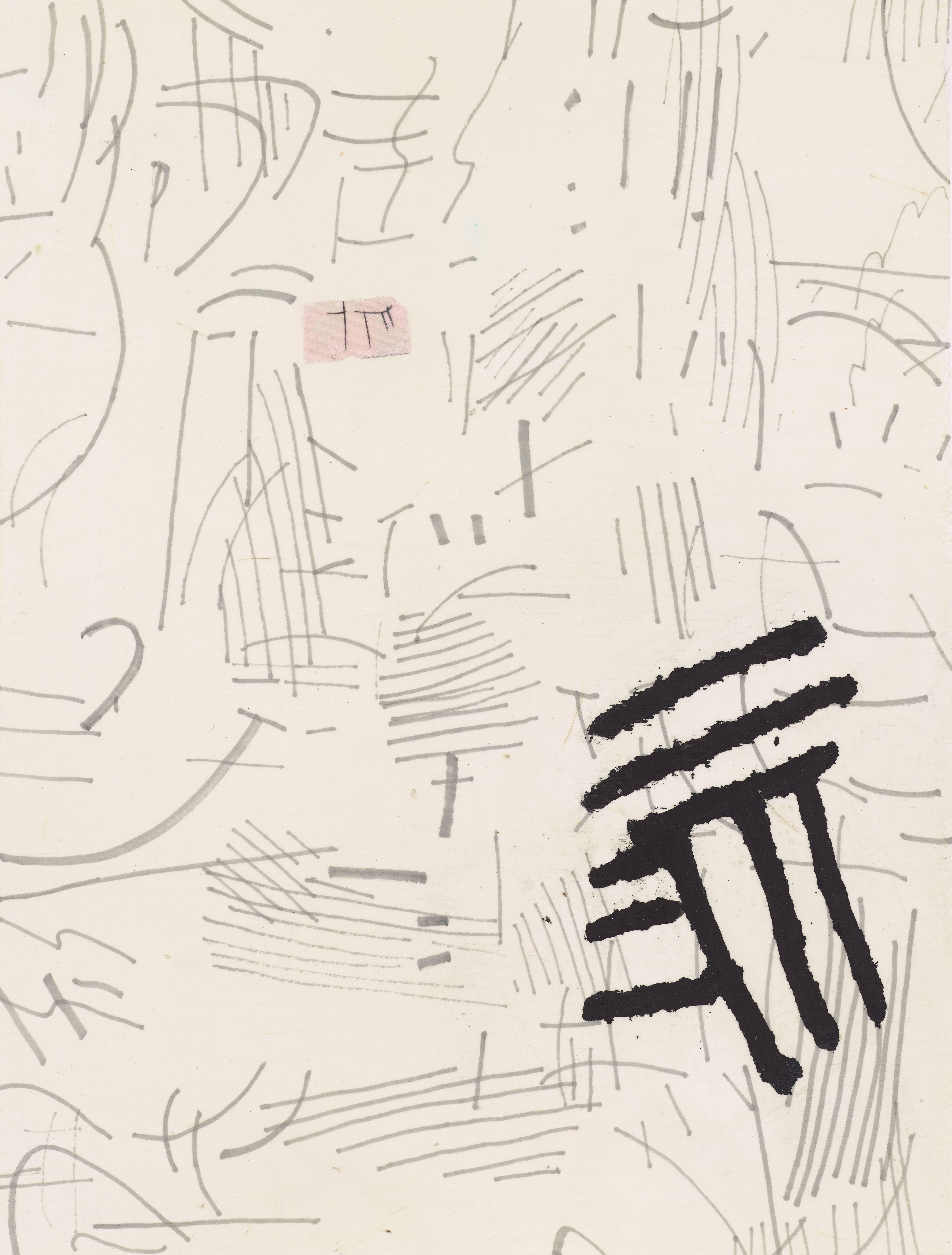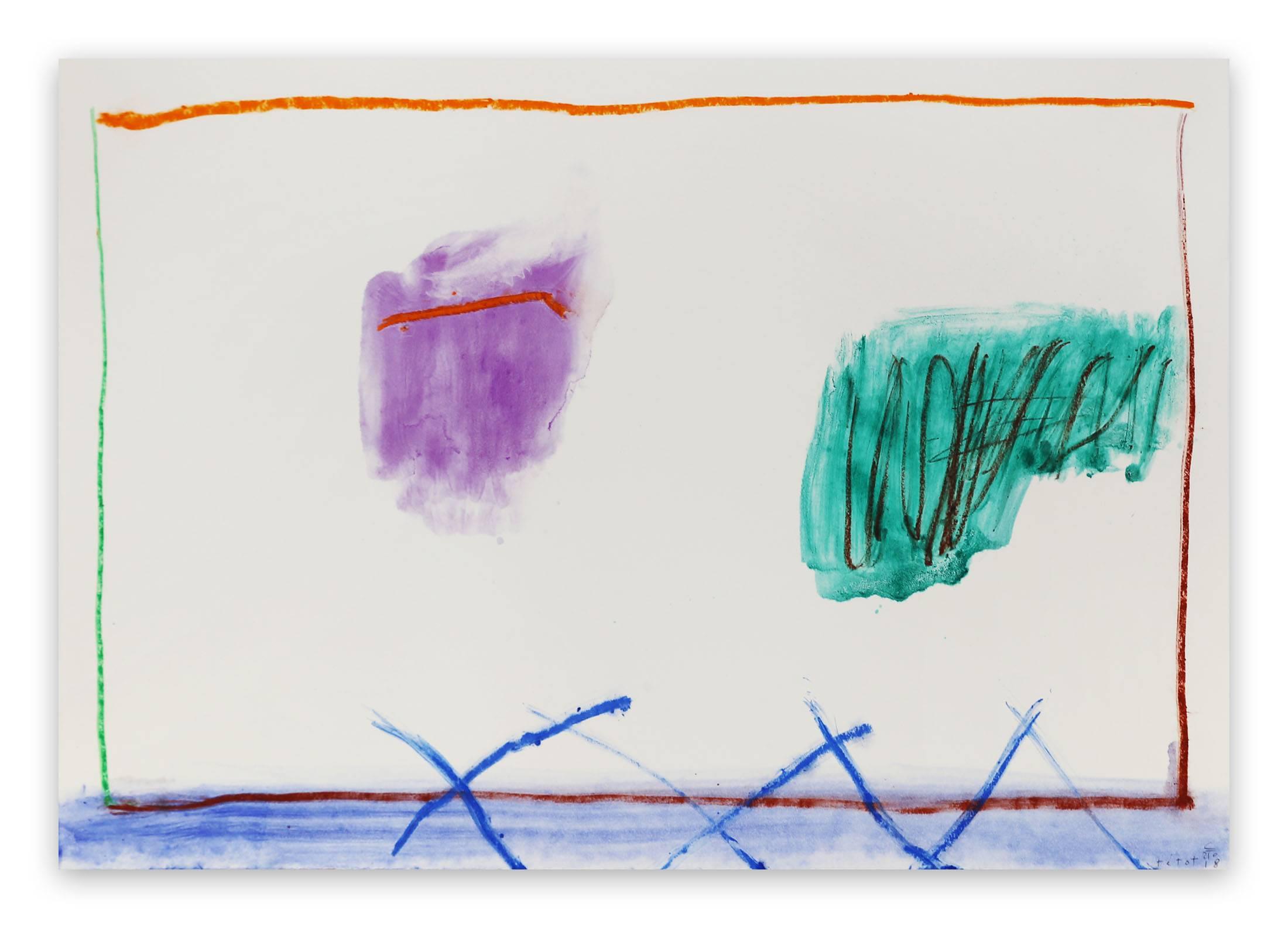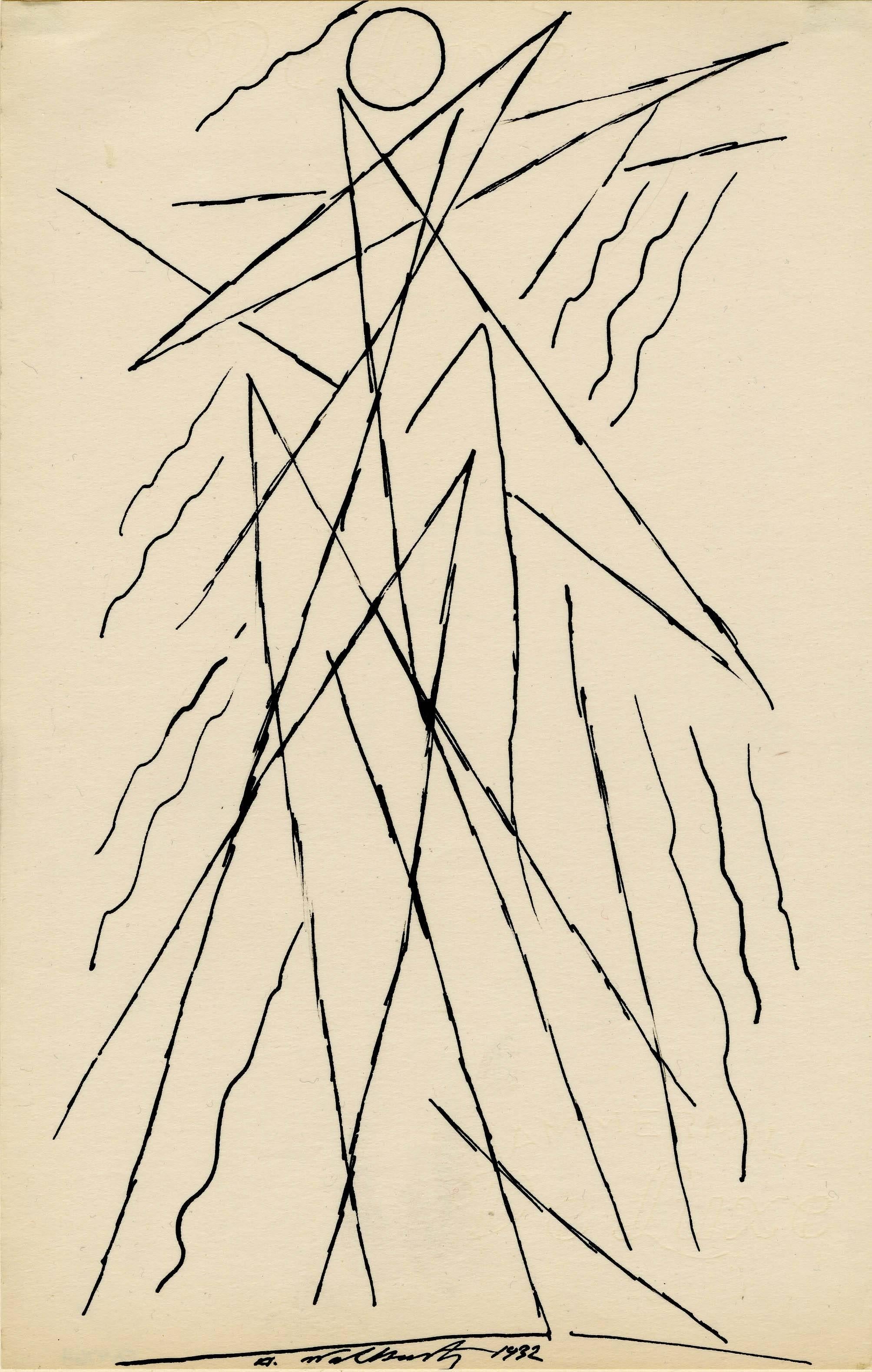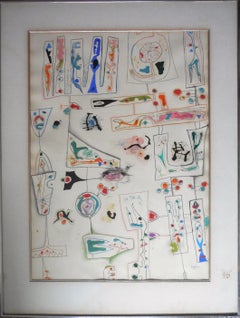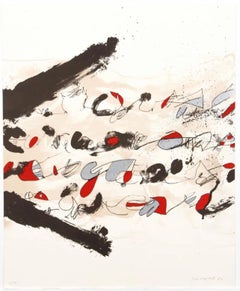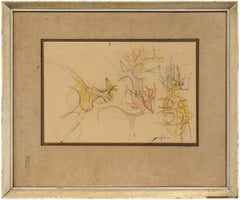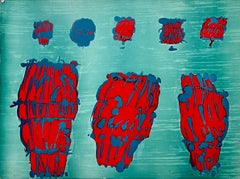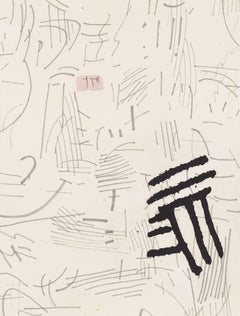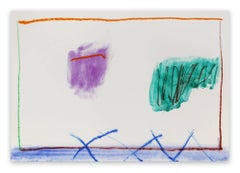Items Similar to Italian Modernist Abstract Drawing, Gestural Lines
Want more images or videos?
Request additional images or videos from the seller
1 of 6
Agostino FerrariItalian Modernist Abstract Drawing, Gestural Linescirca 1980's
circa 1980's
$1,000
£754.10
€872.15
CA$1,402.99
A$1,559.52
CHF 817.46
MX$19,045.46
NOK 10,205.58
SEK 9,601.54
DKK 6,509.49
About the Item
Agostino Ferrari was born in Milan on 9 November 1938.
He commenced his career as as professional artist in 1959.
In 1961 he held his first one-man show at the Galleria Pater, in Milan.
Together with his friends, the painters Arturo Vermi, Angelo Verga, Ettore Sordini, Ugo La Pietra, and the poet Alberto Lùcia, he founded the Gruppo del Cenobio in 1962.
In the same year he held a one-man show at the Galleria del Cenobio in Milan.
It was at this time that emerged what has been the guiding thread of his work right up until the present day: the sign. In 1963 the sign was transformed into out-and-out writing, a multicolored and dynamic script; this was the period of the Manifestos.
In 1964-1965 he made two visits to New York.
From 1966 to 1967 his work showed a tendency toward plasticity that led him to investigate the possibility of putting the sign in relation with a Total Form; Lucio Fontana presented one of his exhibitions.
At the same time, and up until 1971, Ferrari resumed his investigation of sign and produced pictures in which a transparent surface represented the Symbol-Sign, while the positive Physical Sign was in relief and the negative Physical Sign was cut into the surface. These made up the Theater of Sign.
From 1972 to 1975 he sought to determine the psychological reactions that colors produced in him, and in particular the interrelationships of these and signs and forms. He gave the title Sign Form Color to these pictures.
In 1972 at the Galleria San Fermo and in 1974 at the Museo della Scienza e della Tecnica, both in Milan, he presented Sign Form Color as an installation set up within the space 20,000,000 Light Years designed by Vermi.
This work led on to the realization of a large-scale work in 1975: the Self Portrait, exhibited at the Art 6/75 in Basel and then in the Rotonda della Besana in Milan.
In 1978 the desire emerged to return to the sign as a means of expression, as the only element that fitted closely with his states of mind. As a result he produced Gardens and Memories, works made up of sign-signals, as "gestures" in bright colors, in an attempt to develop a less rigorously theoretical form of sign-painting. Out of this experience carne his desire for a "refoundation." He held a series of exhibitions in various countries: in New York, Brussels, Dallas, Berlin, Bonn, Frankfurt, Cologne, and so on.
From 1979 to 1982 sign resumed its predominant pIace in works that were concerned with time and memory.
From 1983 to the present day his treatment of sign has centered on the Events, in which the sign is completely free of superstructures and is realized in its totality. Yet the sign is not just the equivalent of writing, it is a sign-symbol, an emblem, created out of sand as it is a material of great "tactile theatricality." Agostino Ferrari lives and works in Milan.
Solo exhibitions from 1990:
1990
Galleria Francis Van Hoof, Anversa
Galleria Lik-Forum, Amburgo
Galleria Giancarlo Apicella, Colonia
Galleria Borgogna Due, Milano
1991
Centro Steccata, Parma
Galleria Allegrini, Brescia
1992
Galleria Panalba, Marsiglia
College d'Changes Contemporains, Cloître du Convent Royal St. Maximin
Museo di Roma, Palazzo Braschi, Roma
1993
Galleria Thomas Levy, Amburgo
Galleria l'Opera, Napoli
1994
Sala Carlo Cattaneo, Consolato Generale d'Italia, Lugano
Galleria Vinciana, Milano
Galleria Breitling, Stoccarda
1995
Galleria Breitling, Stoccarda
1996
Galleria Lorenzelli Arte, Milano
Galleria d'Arte Moderna e Contemporanea Ulivi, Prato
1999
Galleria d'Arte La Colomba, Lugano
2000
Galleria Ferrari, Treviglio, Bergamo
Galleria A.Am, Milano
2001
Galleria Levy, Amburgo-Madrid
2002
Galleria d'Arte l'Ariete, Bologna
Galleria Artestudio, Milano
Galleria Kuranuki, Osaha, Giappone
Galleria d'Arte Moderna e Contemporanea Ulivi, Prato
2003
Galleria Artestudio, Milano / Miart, Milano
Galleria d’arte La Colomba, Lugano
Galleria Ferrari, Bergamo
Museo Civico di Crema
2004
Arte Silva, Seregno
Galleria Roberto Peccolo, Livorno
2005 Galleria Il Castello, Milano
Group exhibitions from 1990:
1990
Torino arte, Centro Steccata, Parma
1994
Percorsi dell'immagine Galleria Sorrenti, Novara
1995
Quale segno, Palazzo Comunale, Sesto Calende
Palazzo Martinengo, Brescia
Galleria Peccolo, Livorno
Artestudio, Milano
Studio Delise, Portogruaro, Venezia
1997
Stadtische Galerie Wolfsburg Schloß Wolfsburg
Istituto Italiano di Cultura, Wolfsburg.
1999
Galleria d'Arte Moderna e Contemporanea Ulivi Aspettando il 2000, Prato
2001
Ferrari e Kubota, Galleria Mastuyama-shi, Giappone
2002
Galleria Terminus, Monaco di Baviera
Premio Nazionale Città di Monza
Galleria Artestudio, Il Gruppo del Cenobio
2003
Arteambiente 1974-1 977 la Salerniana, Erice (TP)
Galleria Artestudio, Miart, Milano
2004
galleria Artestudio, Milano
Miart, Milano
Galleria Centro Steccata, Parma
Artefiera, Bologna
- Creator:Agostino Ferrari (1938, Italian)
- Creation Year:circa 1980's
- Dimensions:Height: 27.5 in (69.85 cm)Width: 20 in (50.8 cm)
- Medium:
- Movement & Style:
- Period:
- Condition:Measurements include frame. Paper has waviness, see photos.
- Gallery Location:Surfside, FL
- Reference Number:1stDibs: LU38211859402
About the Seller
4.9
Platinum Seller
Premium sellers with a 4.7+ rating and 24-hour response times
Established in 1995
1stDibs seller since 2014
1,800 sales on 1stDibs
Typical response time: <1 hour
- ShippingRetrieving quote...Shipping from: Surfside, FL
- Return Policy
Authenticity Guarantee
In the unlikely event there’s an issue with an item’s authenticity, contact us within 1 year for a full refund. DetailsMoney-Back Guarantee
If your item is not as described, is damaged in transit, or does not arrive, contact us within 7 days for a full refund. Details24-Hour Cancellation
You have a 24-hour grace period in which to reconsider your purchase, with no questions asked.Vetted Professional Sellers
Our world-class sellers must adhere to strict standards for service and quality, maintaining the integrity of our listings.Price-Match Guarantee
If you find that a seller listed the same item for a lower price elsewhere, we’ll match it.Trusted Global Delivery
Our best-in-class carrier network provides specialized shipping options worldwide, including custom delivery.More From This Seller
View AllUntitled
By Lawrence Kupferman
Located in Surfside, FL
30X21.25 without the frame. Mixed Media painting and drawing on paper. Lawrence Kupferman had a long and illustrious career as an artist and educator. His work has been exhibited at ...
Category
20th Century Abstract Expressionist Abstract Drawings and Watercolors
Materials
Paper, Mixed Media
Abstract Latin American Art Spanish Catalan Lithograph Josep Guinovart New York
By Josep Guinovart Bertrán
Located in Surfside, FL
Guinovart, Josep (Spanish/Catalan, 1927-2007), Untitled Abstract, 1984, lithograph on paper, hand signed, dated and marked E.A. (artist's proof) in pencil at bottom, full sheet 26.75 x 22 inches, unframed.
Josep Guinovart (1927 –2007) was a Spanish Catalan painter most famous for his informalist or abstract expressionist work.
In 1941, he began to work as a decorator. Three years later, he started his studies at the Escuela de Artes y Oficios de la Llotja (Art School of La Llotja) where he stayed until 1946.
He first exhibited his work in 1948 in Galerías Syla in Barcelona. In 1951, he produced his first engravings entitled 'Homage to Federico García Lorca'. Two years later, he was awarded a grant from the French Institute to study in Paris for nine months. Here he discovered the cubist works of Henri Matisse and Pablo Picasso and travelled to Belgium, Holland and Germany.
On his return to Barcelona and after a period working as an illustrator and set designer, around 1957 he began moving towards abstract art. His work is highly unconventional and usually on a large scale, using a wide range of materials, three-dimensional objects and organic substances such as eggshell, earth and straw.
In 1962, he illustrated a book of poetry entitled Posies by Joan Salvat-Papasseit for the Ariel Editorial. He won many accolades for his work throughout the 1970s and 80s, including Spain's National Award for Plastic Arts in 1982. In 1994, a museum foundation dedicated to his art was inaugurated in Agramunt, his mother's birthplace to which he always felt a special attachment.
In 2006 he designed the winery Mas Blanch i Jové in La Pobla de Cérvoles (Lleida) and created The Artists' Vineyard, a project intended to mix sculptures and other art works from different artists in the middle of a vineyard. The Artists' Vineyard was inaugurated after his death in 2010 with the unveiling of his sculpture The Countryside Organ: a music instrument, 6 meters height, for the wind to sing the vines. This winery also displays the 10.5 meters work In Vino Veritas...
Category
1980s Abstract Abstract Prints
Materials
Lithograph
Fragments of August
By Lawrence Kupferman
Located in Surfside, FL
Lawrence Kupferman was born in the Boston area (b.1909 - d.1982) , and he became one of the most important abstract artists to emerge from there in the early 1940s. Kupferman worked as an artist for the WPA in the 1930s, developing a strictly realist style that depicted Victorian houses and other detailed architectural images.
Around 1943 Kupferman began to integrate more expressionistic forms into his works. He soon moved completely away from recognizable subject matter and definitively became an abstract painter. In 1946 he studied with the influential German-born artist Karl Zerbe at the School of the Museum of Fine Arts in Boston. Kupferman later attended the Massachusetts College of Art, where he would become a professor and retire as its Head of Painting in 1969. His focus, as it would remain until the late 1960s, was on abstract, marinelike amoeboid forms—intimated, rather than strictly described.
Kupferman was an active participant in a huge thrust in Boston art in the 1940s to create a vibrant art scene that rivaled New York. He has been appropriately credited with bringing Abstract Expressionism to Boston, serving as a critical artistic conduit to New York painters such as Mark Rothko and Hans Hofmann, contacts he made in Provincetown, Massachusetts, where he spent his summers beginning in 1946. Kupferman’s unique brand of abstraction integrated with the already burgeoning figurative expressionism in Boston, and he showed at the Boris Mirksi Gallery, arguably the most important Boston gallery...
Category
20th Century Abstract Abstract Drawings and Watercolors
Materials
Pencil, Color Pencil
Pietro Consagra Italian Mod Abstract Expressionist Forma, Art Brut Lithograph
By Pietro Consagra
Located in Surfside, FL
Pietro Consagra (Italian, 1920-2005).
Hand signed in pencil and numbered limited edition color lithograph on Magnani paper.
Embossed stamp with limited edition numbers in pencil to lower left, and having artist pencil signature to lower right.
(from a limited edition of 80 with 15 artist's proofs)
Published by Stamperia 2RC, Rome Italy and Marlborough Gallery, Rome, Italy.
Abstract Modernist work in colors, produced in the style of the Forma art movement of Postwar Italy, of which the artist was a prominent member.
Pietro Consagra (1920 – 2005) was an Italian Post war artist working in painting, printmaking and sculpture. In 1947 he was among the founding members of the Forma 1 group of artists, proponents of structured abstraction. (similar to the Art Informel and Art Brut in France and the Brutalist artists)
Consagra was born on 6 October 1920 in Mazara del Vallo, in the province of Trapani in south-western Sicily, to Luigi Consagra and Maria Lentini. From 1931 he enrolled in a trade school for sailors, studying first to become a mechanic, and later to become a captain. In 1938 he moved to Palermo, where he enrolled in the liceo artistico; despite an attack of tuberculosis, he graduated in 1941, and in the same year signed up at the Accademia di Belle Arti, where he studied sculpture under Archimede Campini. After the Invasion of Sicily and the Allied occupation of Palermo in 1943, Consagra found work as a caricaturist for the American Red Cross club of the city; he also joined the Italian Communist Party. Early in 1944, armed with a letter of introduction from an American officer, he travelled to Rome. There he came into contact with the Sicilian artist Concetto Maugeri, and through him with Renato Guttuso, who was also Sicilian and who introduced him to the intellectual life of the city and to other postwar artists such as Leoncillo Leonardi, Mario Mafai and Giulio Turcato. Consagra signed up at the Accademia di Belle Arti di Roma in September 1944 and studied sculpture there under Michele Guerrisi, but left before completing his diploma.
In 1947, with Carla Accardi, Ugo Attardi, Piero Dorazio, Mino Guerrini, Achille Perilli, Antonio Sanfilippo and Giulio Turcato, Consagra started the artist's group Forma 1, which advocated both Marxism and structured abstraction.
Steadily Consagra's work began to find an audience. Working primarily in metal, and later in marble and wood, his thin, roughly carved reliefs, began to be collected by Peggy Guggenheim and other important patrons of the arts. He showed at the Venice Biennale eleven times between 1950 and 1993, and in 1960 won the sculpture prize at the exhibition. During the 1960s he was associated with the Continuità group, an offshoot of Forma I, and in 1967 taught at the School of Arts in Minneapolis. Large commissions allowed him to begin working on a more monumental scale, and works of his were installed in the courtyard of the Foreign Ministry in Rome and in the European Parliament, Strasbourg. His work is found in the collections of The Tate Gallery, London, in Museo Cantonale d'Arte of Lugano and the Museum of Modern Art, Paris, and the National Gallery of Art in Washington, D.C..
Consagra returned to Sicily where he sculpted a number of significant works during the 1980s. With Senator Ludovico Corrao, he helped created an open-air museum in the new town of Gibellina, after the older town had been destroyed in the earthquake of 1968. Consagra designed the gates to the town's entrance, the building named "Meeting" and the gates to the cemetery, where he was later buried.
In 1952 Consagra published La necessità della scultura ("the need for sculpture"), a response to the essay La scultura lingua morta ("sculpture, a dead language"), published in 1945 by Arturo Martini. Other works include L'agguato c'è ("the snare exists", 1960), and La città frontale ("the frontal city", 1969). His autobiography, Vita Mia, was published by Feltrinelli in 1980. In 1989 a substantial retrospective exhibition of work by Consagra was shown at the Galleria Nazionale d'Arte Moderna in Rome; in 1993 a permanent exhibition of his work was installed there. In 1991 his work was shown in the Hermitage Museum in St. Petersburg. In 2002 the Galerie der Stadt Stuttgart opened a permanent exhibition of his work. He was one of ten artists invited by Giovanni Carandente, along with David Smith, Alexander Calder, Arnaldo Pomodoro, Lynn Chadwick, and Beverly Pepper, to fabricate works in Italsider factories in Italy for an outdoor exhibition, "Sculture nella città", held in Spoleto during the summer of 1962. He was included in the The 1962 International Prize for Sculpture the jury included Argan, Romero Brest and James Johnson Sweeney the former director of the Solomon R. Guggenheim Museum in New York. The participants included Louise Nevelson and John Chamberlain for the United States; Lygia Clark for Brazil; Pietro Consagra, Lucio Fontana, Nino Franchina, and Gió Pomodoro for Italy; Pablo Serrano for Spain; and Eduardo Paolozzi, William Turnbull, and Kenneth Armitage for England. Gyula Kosice, Noemí Gerstein, Julio Gero, Naum Knop...
Category
1960s Abstract Expressionist Abstract Prints
Materials
Lithograph
UNTITLED FIGURES (LINES AND SHAPES AGAINST TEXTURAL BACKGROUND)
By Shoshana Heimann
Located in Surfside, FL
As fate would have it, sculptor, painter and printmaker Shoshana Heimann (1923-2009) did not live to see her retrospective installed at both the Hecht Museum at the University of Hai...
Category
Mid-20th Century Modern Abstract Paintings
Materials
Wood, Mixed Media, Oil
Italian Artist Abstract Lithograph
By Renzo Eusebi
Located in Surfside, FL
Renzo Eusebi, Born in Patrignone di Montalto Marche, Italy, 1946
In the 1960s he completed his artistic studies in Rome, followed the classic route and qualified for teaching which h...
Category
Late 20th Century Abstract Abstract Prints
Materials
Lithograph
You May Also Like
Untitled
By Margo Margolis
Located in Wellesley, MA
"Untitled," Flashe on Paper, 30 x 22 Inches
A highly sophisticated series of large and small paintings, drawings and monoprints by Margo Margolis, NY artist who recently retired as...
Category
2010s Abstract Abstract Drawings and Watercolors
Materials
Other Medium
Untitled 4 (Abstract Painting)
By Claude Tétot
Located in London, GB
Untitled 4 (Abstract Painting)
Acrylic and oil on paper - Unframed
Claude Tétot is a French abstract artist whose work expresses harmony in disharmony b...
Category
2010s Abstract Expressionist Abstract Drawings and Watercolors
Materials
Paper, Oil, Acrylic
Untitled 4 (Abstract Painting)
By Claude Tétot
Located in London, GB
Untitled 4 (Abstract Painting)
Acrylic and oil on paper - Unframed
Claude Tétot is a French abstract artist whose work expresses harmony in disharmony by exploring the enigmatic un...
Category
2010s Abstract Expressionist Abstract Drawings and Watercolors
Materials
Paper, Oil, Acrylic
Untitled 4 (Abstract Painting)
By Claude Tétot
Located in London, GB
Untitled 4 (Abstract Painting)
Acrylic and oil on paper - Unframed
Claude Tétot is a French abstract artist whose work expresses harmony in disharmony by exploring the enigmatic un...
Category
2010s Abstract Expressionist Abstract Drawings and Watercolors
Materials
Paper, Oil, Acrylic
Untitled 4 (Abstract painting)
By Claude Tétot
Located in London, GB
Acrylic and oil on paper - Unframed
Claude Tétot is a French abstract artist whose work expresses harmony in disharmony by exploring the enigmatic unity that can exist between seemi...
Category
2010s Abstract Expressionist Abstract Drawings and Watercolors
Materials
Paper, Oil, Acrylic
Abstraction
By Abraham Walkowitz
Located in Fairlawn, OH
Signed and dated in ink lower center
Provenance:
Charlotte Bergman, noted collector and patron of Walkowitz. See photo for additional information.
Category
1930s Modern Abstract Drawings and Watercolors
Materials
Ink, Pen
